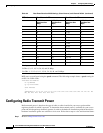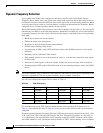
6-19
Cisco IOS Software Configuration Guide for Cisco Aironet Access Points
OL-29225-01
Chapter 6 Configuring Radio Settings
Configuring Radio Channel Settings
If radar is detected on a manually configured DFS channel, the channel will be changed automatically
and will not return to the configured channel.
Prior to transmitting on any channels listed in Table 6-4, the access point radio performs a Channel
Availability Check (CAC). The CAC is a 60 second scan for the presence of radar signals on the channel.
The following sample messages are displayed on the access point console showing the beginning and
end of the CAC scan:
*Mar 6 07:37:30.423: %DOT11-6-DFS_SCAN_START: DFS: Scanning frequency 5500 MHz for
60 seconds
*Mar 6 07:37:30.385: %DOT11-6-DFS_SCAN_COMPLETE: DFS scan complete on frequency
5500 MHz
When operating on any of the DFS channels listed in Table 6-4, in addition to performing the CAC, the
access point constantly monitors the channel for radar. If radar is detected, the access point stops
forwarding data packets within 200 ms and broadcasts five beacons that include an 802.11h channel
switch announcement, indicating the channel number that the access point begins using. The following
example message displays on the access point console when radar is detected:
*Mar 6 12:35:09.750: %DOT11-6-DFS_TRIGGERED: DFS: triggered on frequency 5500 MHz
When radar is detected on a channel, that channel may not be used for 30 minutes. The access point
maintains a flag in non-volatile storage for each channel that it detects radar on in the last 30 minutes.
After 30 minutes, the flag is cleared for the corresponding channel. If the access point is rebooted before
a flag is cleared, the non-occupancy time is reset to 30 minutes when the channel initializes.
Note The maximum legal transmit power is greater for some 5-GHz channels than for others. When it
randomly selects a 5-GHz channel on which power is restricted, the access point automatically reduces
transmit power to comply with power limits for that channel.
Note We recommend that you use the world-mode dot11d country-code configuration interface command to
configure a country code on DFS-enabled radios. The IEEE 802.11h protocol requires access points to
include the country information element (IE) in beacons and probe responses. By default, however, the
country code in the IE is blank. You use the world-mode command to populate the country code IE.
Radar Detection on a DFS Channel
When an access point detects a radar on a DFS channel, the access point creates a file in its flash memory.
The file is based on the 802.11a radio serial number and contains the channel numbers on which the radar
is detected. This is an expected behavior and you should not remove this file.
CLI Commands
The following sections describe CLI commands that apply to DFS.


















